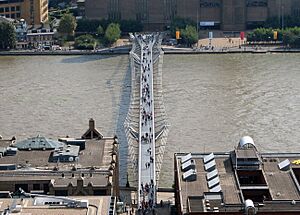Millennium Bridge facts for kids
Quick facts for kids Millennium Bridge |
|
|---|---|

The bridge seen from a restaurant in the Tate Modern gallery. St. Paul's Cathedral is across the river.
|
|
| Carries | Pedestrians |
| Crosses | River Thames |
| Locale | London, England |
| Official name | London Millennium Footbridge |
| Maintained by | Bridge House Estates, City of London Corporation |
| Characteristics | |
| Design | Suspension Bridge |
| Total length | 370 metres (1,214 ft) |
| Width | 4 metres (13 ft) |
| Longest span | 144 metres (472 ft) |
| History | |
| Opened | 10 June 2000 |

The Millennium Bridge is a special bridge in London, England. It is only for people walking, not cars. This bridge crosses the famous River Thames. It connects two parts of London: Bankside and the City.
The Millennium Bridge is a steel suspension bridge. This means it hangs from strong cables. It is located between Southwark Bridge and Blackfriars Railway Bridge. The bridge first opened on June 10, 2000. It was the newest bridge built across the Thames at that time.
Londoners gave the bridge a funny nickname: the Wobbly Bridge. This happened because people felt it sway uncomfortably when they walked on it. The bridge had to close on the very day it opened. After being open for only two days with limited access, it closed for almost two years. Engineers made big changes to stop the wobble. The bridge reopened in 2002 and has been stable ever since.
The south end of the bridge is close to famous places like Globe Theatre, the Bankside Gallery, and Tate Modern. The north end is near the City of London School and St Paul's Cathedral. From the bridge, you get a clear view of St Paul's Cathedral. The bridge's supports perfectly frame the cathedral's south side.
Contents
How Was the Millennium Bridge Designed?
The idea for the Millennium Bridge came from a competition in 1996. Southwark council organized this contest. The winning design was created by three groups: Arup, Foster and Partners, and Sir Anthony Caro.
The bridge uses eight strong suspension cables. These cables pull with a force of 2,000 tons. This force is held by large supports on each side of the river. The bridge is built to hold up to 5,000 people at one time.
Why Did the Millennium Bridge Wobble?
The bridge closed just three days after it opened. This caused a lot of talk and some embarrassment. People wondered why engineers had not seen the problem. Today, computer models are often used to test designs.
The bridge's wobbling was caused by something called 'positive feedback'. When people walked, their natural sway made the bridge move a little sideways. This small movement then caused other people on the bridge to sway in the same way. This made the bridge swing even more, making the wobble stronger.
The bridge opened on a very nice day. It was also part of a big charity walk. On opening day, 90,000 people crossed the bridge. At times, up to 2,000 people were on the bridge together.
How Was the Wobble Fixed?
The problem with the Millennium Bridge's sideways shaking was unusual. However, it was not the only bridge to have this issue. Other bridges that had similar problems include:
- The Birmingham NEC Link bridge.
- The Groves Suspension Bridge in Chester in 1977.
- The Auckland Harbour Road Bridge in 1975.
Engineers studied the problem carefully. They fixed it by adding 37 special devices called dampers. These dampers help control sideways movement. They also added 52 other dampers to control up-and-down movement. This repair work took from May 2001 to January 2002. It cost about £5 million.
After being tested, the bridge successfully reopened on February 22, 2002. Since then, the bridge has not wobbled significantly. Even though the problem was fixed, many Londoners still lovingly call it the 'Wobbly Bridge'.
Related pages
See also
 In Spanish: Puente del Milenio para niños
In Spanish: Puente del Milenio para niños


